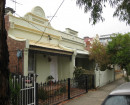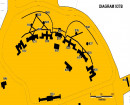BROUGHTON HALL
2 BERWICK STREET CAMBERWELL, BOROONDARA CITY
-
Add to tour
You must log in to do that.
-
Share
-
Shortlist place
You must log in to do that.
- Download report



Statement of Significance
What is significant?
Broughton Hall (formerly know as Tara) was constructed in c.1858 for Sir John O'Shanassy, one of the colony's early immigrants and three times Premier (1857; 1858-1859 and 1861-1863). The house was extended in 1883. Broughton Hall was occupied by the O'Shanassy family until the end of the nineteenth century. It was privately owned and occupied by various people until purchased by the Anglican Church in 1951. The two-storey building is an early Italian Renaissance Revival mansion with an open terrace to three sides which includes refined ornamentation. Internally, the building includes an entrance hall decorated with a cast-metal dado frieze based upon the Ghiberti Frieze on the doors of the baptistery of St John the Baptist in Florence.
How is it significant?
Broughton Hall is of historic and architectural significance to the State of Victoria
Why is it significant?
Broughton Hall is of historical importance through its association with John Sir John O'Shanassy, an Irish immigrant and one of Victoria's early settlers, who was also Premier of the Colony of Victoria on three occasions. Broughton Hall is of social and cultural importance through its ability to demonstrate the opportunities available to early settlers in the newly-established colony of Victoria. The building illustrates O'Shanassy's prominence of in society through is grand interior opulence and ornate exterior and demonstrates the need of some colonists' to establish status through grand residences. Broughton Hall is architecturally important as an unusual demonstration of the Italian Renaissance style, not popularised until the boom period of the 1870s and 1880s. It is important architecturally for its opulent interior in the Italian style which demonstrates good design, aesthetic characteristics and a richness, diversity and integration of features unusual for the period in which it was constructed.
-
-
BROUGHTON HALL - History
The land and building
Tenders were called by architect JM Barry, in June 1858, to erect ‘...a MANSION and OUTOFFICES at Boroondara, for the Hon. John O’Shanassy, Chief Secretary’.[1] So ended the evolution of Tara to near its present form, given that the facade was completed by 1859. A photograph taken by Cox & Luckin in 1861 for the Melbourne and London International Exhibitions shows the facade much as it is now.[2] The municipal valuation of 1861 gave this property the highest annual valuation although other mansions had been built in the area.
Later in 1883, tenders were called by William Salway for ‘additions, alterations and repairs to Tara, Camberwell for Mr. O’Shanassy’, and, prior to that, by architects William Ellis for new stabling.[3] The Argus of 1884 described the completed interior decoration by Mr Robert Reid and the reconstruction of the interior by Mr William Salway.[4] Reid achieved a great deal of publicity for his creations in the 1880s. His designs from the Ducal Palace at Mantua were used in JM Bruce’s Wombaleno where the Argus was able to comment that the cabinet work, gas brackets, brass door furniture were locally made although the carpets and ‘hanging’ were imported from the ‘Old Country’.[5]By 1884, Matthew Patrick O’Shanassy was the resident gentleman owner of the 18 room Tara and 46 acres surrounding.[6] A brief change of occupancy occurred in 1888 when George Langridge, auctioneer, leased Tara. He also purchased 45 acres of the grounds and subdivided it in this boom year of 1888. Matthew regained possession by 1893 until his death in 1900 after which John Coupar, warehouseman, owned and occupied the house. Mrs Annie Coupar continued there for many years early this century, followed by a Mrs M Leets in the 1930s. The house was the Tara Guest House in the 1930s. During Mrs Cooper’s period, the lots between Tara and Burke Road were divided into the Tara Estate.
Sir John O’Shanassy
Sir John O’Shanassy, Irish born, arrived at the threshold of the Colony, in 1839. His business (drapery) interests thrived as did his role with the Roman Catholic Church, so founding the St Patrick’s Society and working for charitable institutions generally. He served as a Melbourne councillor, member of the Denominational Schools Board and a Public Library trustee. He was also active among building and land societies and an important figure in the establishment and running of the Colonial Bank.
Elected to Victoria’s first Legislative Council he served as a virtual opposition leader until 1857 when a new government was formed with O’Shanassy as its Premier and Chief Secretary for a bare month. He re-emerged in this role in 1858 and 1861. During these sessions the Crown Land Act 1862 and Local Government Act 1862-3 were major legislative achievements, the latter receiving ‘...much of Mr. O’Shanassy’s attention’. Failing health meant cessation of politics and a world tour when Pope Pius IX knighted him into the Order of St. Gregory for his efforts in Catholic education.
On his return he entered the Legislative Council in 1868 and 1872-4 and the Assembly in 1877: pursuing in both theatres a conservative view of the Catholic cause until his defeat at Belfast (Port Fairy) in 1883. A knighthood awaited him at his retirement from the Council. He died in 1883 as did his widow, in 1887; both dates marking both the enrichment and dissipation of Tara. Near to his death O’Shanassy was criticised for his supposed influence over the path of the railway to Hawthorn at Camberwell. The route, which had been first announced in 1876, passed half a mile north of the junction, close to Sir John’s property, and trains traversed, some thought, unnecessarily steep grades to get there when it opened in 1882.
William Cooper
Yorta Yorta activist and Aboriginal social justice campaigner William Cooper (1860-1941) spoke of living at Tara as a young boy for three years from the age of eight. Cooper was born around 1860 near the Moira Lakes, close to the junction of the Murray and Goulburn Rivers near present day Echuca-Moama. A large portion of Cooper's ancestral country had been 'selected' several decades earlier for the establishment of Moira Station, a huge pastoral property that was leased and operated by O'Shanassy during that period. Cooper recalled being taken from Moira Station to Melbourne at around the age of eight to work in O'Shanassy's stables, both at Tara and at O'Shanassy's business located in central Melbourne (known as the New Imperial Hotel). Around three years later Cooper returned to Yorta Yorta country, his mother Kitty, and his seven siblings.
Architectural significance
Architecturally, Tara is of an uncommon and refined, very early Italian Renaissance revival mansion form, given its open terrace to three sides and sophisticated ornamentation. It is perhaps the oldest of this type and style surviving in the State. Historically, Tara was for a long period the home of one of Victoria’s more distinguished politicians and foremost figures of the Catholic Church. This is still reflected in the outward form. The house exterior is unusually ornate and grand for a privately owned mansion of the 1850s. The ornate ornament of the redecorated interior reflects the opulence of the 1880s in way unmatched by any other private house (friezes).
Comparable residential facades exist at 154 Hotham Street and 116 Wellington Parade, East Melbourne; at Oberwyl, Burnett Street, St. Kilda (particularly the open terrace); The Terricks, Paterson Street, Hawthorn (more ornate); and Wanganella, Aird Street, Camberwell, which also has an open terrace. Of note is that the now demolished Rostella of Lonsdale Street, also designed by Barry, had an open terrace over a loggia (1869).
BROUGHTON HALL - Permit Exemptions
General Exemptions:General exemptions apply to all places and objects included in the Victorian Heritage Register (VHR). General exemptions have been designed to allow everyday activities, maintenance and changes to your property, which don’t harm its cultural heritage significance, to proceed without the need to obtain approvals under the Heritage Act 2017.Places of worship: In some circumstances, you can alter a place of worship to accommodate religious practices without a permit, but you must notify the Executive Director of Heritage Victoria before you start the works or activities at least 20 business days before the works or activities are to commence.Subdivision/consolidation: Permit exemptions exist for some subdivisions and consolidations. If the subdivision or consolidation is in accordance with a planning permit granted under Part 4 of the Planning and Environment Act 1987 and the application for the planning permit was referred to the Executive Director of Heritage Victoria as a determining referral authority, a permit is not required.Specific exemptions may also apply to your registered place or object. If applicable, these are listed below. Specific exemptions are tailored to the conservation and management needs of an individual registered place or object and set out works and activities that are exempt from the requirements of a permit. Specific exemptions prevail if they conflict with general exemptions. Find out more about heritage permit exemptions here.Specific Exemptions:Interior decorative schemes
- Interior painting/wallpapering to walls and ceilings dating from post-1885, provided the preparation work for painting/papering does not remove evidence of the building's original paint or other decorative scheme.
- Removal of exisiting non-original carpets/flexible floor coverings (eg: vinyl) and installation of new coverings to these areas.
- Removal of non-original window dressings/treatments.
- Installation of curtain track, rod, blinds.
Refurbishment of bathrooms, toilets, kitchens
- Refurbishment of bathroom/toilet/ensuite including removal of existing sanitary fixtures and associated piping, mirrors and floor coverings, and installation of new fixtures, and wall and floor coverings.
- Removal of existing benches and fixtures (stoves, dishwashers etc) and floor coverings and installation of new benches and fixtures, including associated plumbing and wiring.
-
-
-
-
-
FORMER ES&A BANK
 Victorian Heritage Register H0534
Victorian Heritage Register H0534 -
PARLINGTON
 Victorian Heritage Register H0731
Victorian Heritage Register H0731 -
FROGNALL
 Victorian Heritage Register H0707
Victorian Heritage Register H0707
-
"1890"
 Yarra City
Yarra City -
"AMF Officers" Shed
 Moorabool Shire
Moorabool Shire -
"AQUA PROFONDA" SIGN, FITZROY POOL
 Victorian Heritage Register H1687
Victorian Heritage Register H1687
-
'Altona' Homestead (Formerly 'Laverton' Homestead) and Logan Reserve
 Hobsons Bay City
Hobsons Bay City
-
-















